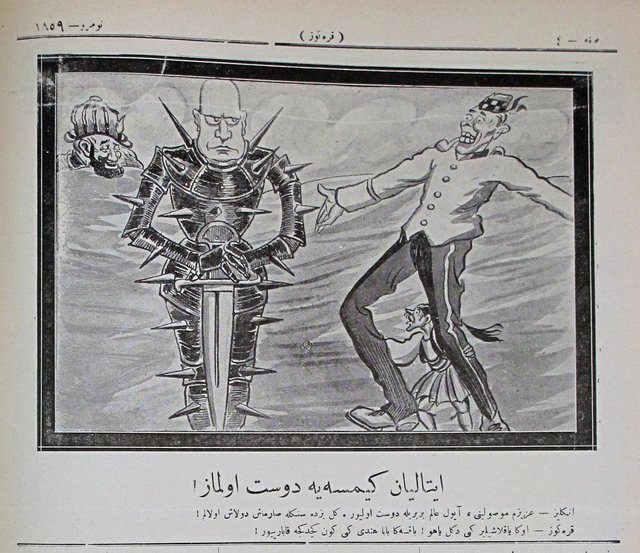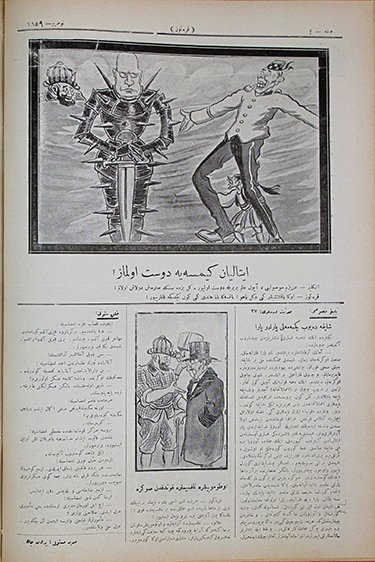50. Today in 1920s Turkey: 9 January 1926 (Mussolini: Europe’s Prickly Pear)

(Cartoon, Karagöz, 9 January 1926, no. 1859, page 4.)
Comments:
This cartoon presents four fairly recognizable characters to its readers. On the right is John Bull, a common personification of Britain. As is typical of Turkish renderings of John Bull, he is depicted as a tall and lanky, pipe-smoking man. Opposite John Bull is a caricature of Benito Mussolini, Italy’s infamous Il Duce. He is pictured enwrapped in an armor covered in spikes and holding a large sword very close to his body. His icy glare and reserved pose contrasts with the demeanor of John Bull whose open arms and great big smile suggests a more than chummy mood.
In addition to these two larger figures there is a diminutive personification of Greece at the heels of the Englishman. Like John Bull, this rendering of Greece is typical in Turkish cartoons of this period. There was no love lost between the Greeks and Turks after the Greco-Turkish War (1919-1922) which was still recent history at that time. Thus, during the war and for some time afterwards Turkish cartoonists continued to caricature the Greek state in this fashion. The figure is often featured alongside a larger, stronger John Bull who was perceived to be the big brother (protector) of Greece. His garments—consisting of shoes with pom-poms on them and a skirt— reflect an interpretation of the Greek army’s uniform that is feminized and thus meant to be insulting.
The last person who needs no introduction is Karagöz peering over the horizon at this strange gathering. As the mascot of the magazine named after him, Karagöz was always featured in the masthead (see post #15 for an example of the journal’s masthead) and often appeared in the publication’s cartoons. Sometimes he is a passive observer and other times he is an active protagonist. In this case, Karagöz is playing the role of the former. He merely observes and comments on the situation at hand which is understandable since the subject of the cartoon does not directly concern Turkey.
The cartoon reflects the political uncertainties of post-WWI Europe. The relationship between Italy and Britain was strained in the aftermath of the Corfu Incident, an international crisis between Italy and Greece which unfolded in 1923. While this may partially explain Mussolini’s unfriendly demeanor it is also possible that there are other specific events I’m not aware of that this cartoon is referencing. Finally, Mussolini’s iron protective-wear may represent his gradual transforming of Italy into an authoritarian police state with himself at its helm. According to this image, the state apparatus is the very shield that keeps him in power and protected.
For a related post on the Corfu Incident see #17: The Pasta Boycott.
English:
The Italian is a friend to no one!
Englishman: My dear Mussolini, the whole world is befriending one another. Come let us embrace!
Karagöz: He does not look approachable! Will you look at him, he is swelling with self-importance with every passing day!
Türkçe:
İtalyan kimseye dost olmaz!
İngiliz: Azizim Mussolini, ayol alem birbiriyle dost oluyor. Gel biz de seninle sarmaş dolaş olalım!
Karagöz: Ona yaklaşılır gibi değil yahu! Baksana baba hindi gibi gün geçtikçe kabarıyor!

(Entire page, Karagöz, 9 January 1926, no. 1859, page 4.)
This post has been modified, updated, and re-posted on 9 January 2019. Access the new edition here.